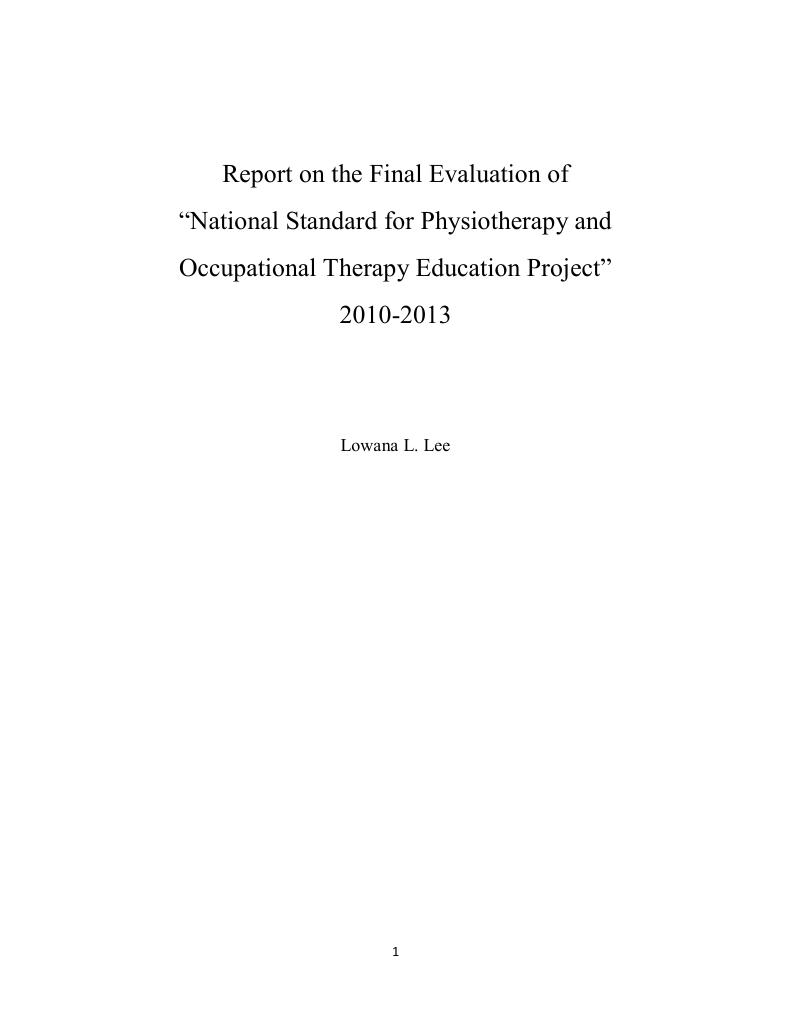Evaluering
Report on the Final Evaluation of “National Standard for Physiotherapy and Occupational Therapy Education Project”
Background: The project, “Holistic Habilitation for Children with Cerebral Palsy” (HH) aims to create a model for a holistic habilitation system for children with CP including education, health care and community based services. The development goal for the project was “to improve the situation for the disabled children in China where they are met with respect and dignity”. To achieve this, the project was separated into two sub-projects. The sub-goal that is the focus of this evaluation is to support the development of a national curriculum for physiotherapy (PT) and occupational therapy (OT) according to an international standard. The final version of the book” Guidelines for OT and PT education” was completed in 2013. Three universities and 100 teachers were selected to be pilot users of the guidelines. Trainings have been given to them in how to use the book to create international standard university specific curriculums for the education of PT and OT in China. Purpose/objective: The purpose of the evaluation is to assess how successful and to what extent the “Guidelines for OT and PT education” booklet had been adopted by the three universities in the planning of the curriculum. The team also would evaluate the process of implementation of the guidelines and the need for changes. Recommendations for the future and the sustainability of the program will also be discussed as this is the last year that Mission Alliance and the Norwegian government would be funding the program. Moreover, the impact of the guidelines on the education of physical and occupational therapists in the nation and subsequent service delivery to the clients were assessed. Methodology:The final evaluation consists of gathering data in the field in late November, 2013 through site visits to Nanjing Medical University, Nan Tong University and Shanghai Traditional Chinese Medicine University. Evaluation methodology includes inspection of relevant documents, onsite evaluations, structured interviews with leaders, focus groups and structured interviews with students and faculties from the three pilot universities. The leaders and faculty heads from the three universities also gave an overview of their present situation and achievements in setting up the new curriculum. The leader of Chinese Association of Rehabilitation Medicine (CARM), the project manager and the leaders in the OT and PT expert panels were interviewed. Key findings: • Based on the interviews and focus groups, the Guidelines on PT and OT Education were confirmed to have been adopted by the three pilot universities as the framework for developing separate curriculum for physical therapy and occupational therapy. The feedback received was generally positive from national rehabilitation leaders, universities leaders, faculties and students. All agreed that the guidelines have an impact in the new curriculum.• The three universities recognized that there is a great lack of qualified PT and OT teachers nationally to teach in the respective disciplines. There is also a tremendous need for qualified pediatric PT and OT to provide clinical preceptorships for students. The pilot universities found an innovative way by inviting qualified therapists trained overseas to teach intense short modules and help with clinical fieldwork.• The publication of the “PT and OT Education Guidelines” is a big step forward to help raise and standardize the training of physical and occupational therapists to an international level. In order for the project development goal to be realized, one still has to await the impact the graduates of the new curriculum will make when they enter the workforce and start treating children with disability.• Leaders of the pilot universities were positive that the guidelines would continue to be used and there will be continual modifications of the curriculum as the teachers start teaching from it. CARM and the expert panel leaders were also optimistic that the guidelines would eventually be adopted by other education institutions in China. Much work still needs to be done as the diploma of rehabilitation therapists are recognized whereas no schools have yet given out diplomas or certificates for a degree in physical therapy or in occupational therapy. Recommendations: • Observations from the field visits in November 2013 confirmed that in order to have a change in the curriculum, support from policy makers and university leaders are very important. Without the endorsement and support from the leaders, changes would be unable to be implemented. It is also very important that these changes are parallel with the philosophy of the Education Department of the country.• There is an acute shortage of professionally trained physical therapists and occupational therapists to act as teachers and clinical instructors/preceptors. Appropriate clinical settings with qualified preceptors will need to accommodate student internship, and pediatric placements and psychosocial occupational therapy placements needs to be in place to complement the new curriculums. In order to support the new curriculum, certain resources need to be put into place.• Many students and teachers also commented on the lack of good teaching material in physical therapy and occupational therapy in the national language. Many textbooks are translated and there is a need for locally trained physical therapists and occupational therapists to write course textbooks in their own language and to contextualize the material to the local culture.• There is also a need for stronger collaboration in the community institutions (government or private) that provide clinical education for the students. This will give support to the clinical preceptors as well as reinforce the theories that the students learnt in school.
